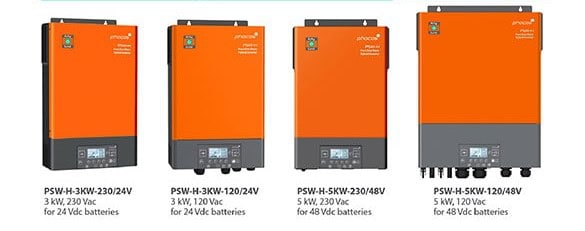Phocos manufactures products for off-grid and hybrid solar applications worldwide. Founded in 2000 in Ulm, Germany their product range spans everything from charge controllers, inverters to DC appliances.
In this comprehensive review, we look at the Phocos Any-Grid™ Inverter Series, taking a closer look at the features, performance, and unique aspects that set these inverters apart from their competitors.
Table of Contents
Quick Summary
Price (5kW): $1,250
Availability: Medium
Ease of Use: Medium
Country of Origin: Germany
Key features: Washable filter for easy cleaning, removable information display unit
Phocos Any-Grid™ Hybrid Inverter Charger Series
In 2019 Phocos launched the Any-Grid™ Hybrid Inverter Charger Series for use in off-grid, on-grid, and hybrid solar systems. The series replaces Pure Sine Wave Solar Inverter PSW Series and the Phocos single and three phase inverters that have been discontinued.
The series consists of two feature-rich inverters: the Any-Grid™ PSW-H Inverter Charger Series and the Any-Grid™ PSW-B Battery Inverter Charger.

The key feature of this series of inverters is their versatility. Available in 3, 5, 6.5, and 8kW, the PSW-H Series is specifically designed for hybrid solar systems that switch between grid-connected and off-grid operation.
Available in sizes ranging from 0.5 to 3 kW, PSW-B Series is ideal for off-grid and on-grid applications.
Both the PSW-H and PSW-B can charge your batteries using either grid, generator, or solar with easily programmable priorities.
Key Features
- Built-in high-voltage MPPT charge controller. The high-voltage PV connection means solar panels can be connected in series of one or two strings, without costly combiner boxes and string fuses or diodes.
- The charge controller functions even when the inverter is turned off to keep the batteries fully charged.
- Remote monitoring & control with the Phocos Any-Bridge™ AB-PLC and PhocosLink Cloud apps.
- Up to 9 inverters can be connected in parallel, 3-phase or split-phase for up to 72 kW of synchronized AC power.
- A washable filter reduces dust buildup in the inverter.
The PSW-H comes with a detachable display unit that allows you to monitor the status of the main inverter unit from another room for example. It can also be used without a battery, powering loads with solar, a generator, or the grid. Other key differences between the PSW-H and PSW-B series are:
- Max input voltage – The PSW-H has a higher maximum input voltage of 450 Vdc compared to the PSW-Bs 145 Vdc. This allows for longer PV array strings with higher voltages. This means less wiring and no need for string fuses.
- Max charge current – The PSW-H and PSW-B have a charge current of 80A and 60A respectively. The PSW-B has 25% less amps for battery charging which makes the PSW-H a more efficient option for larger arrays.
- Grid interactive – The PSW-H is grid interactive meaning you can use AC grid/generator and solar simultaneously. The PSW-B can power your loads using either solar/battery or AC at a time, never both.
- Battery-free mode – The PSW-H can be used without a battery whereas the PSW-B always has to have a battery.
How Does Phocos Stack Up Against Other Inverter Brands?
Phocos inverters are German engineered and manufactured in Asia. They’re much more expensive than a Must, Growatt or Mecer inverter which cost $650, $850 and $800 respectively. The only inverter that costs more locally is a Victron which will set you back $2,050.
With that said, Phocos is a quality product. The detachable display and dedicated inverter app are nice-to-have features that distinguish it from other brands.
Phocos Inverter Alternatives
Final Thoughts
If you’re wary of the cheaper brands and you’re after something with better build quality then Phocos is a good bet. The versatility of the Any-Grid series means they are ideal for just about any solar application.
Overall, Phocos is a solid choice if you have a higher budget and want a few extra bells and whistles for your system.
Still not sure how Phocos measures up against the competition? Check out our side-by-side comparison of the best solar inverters for first-time solar owners.